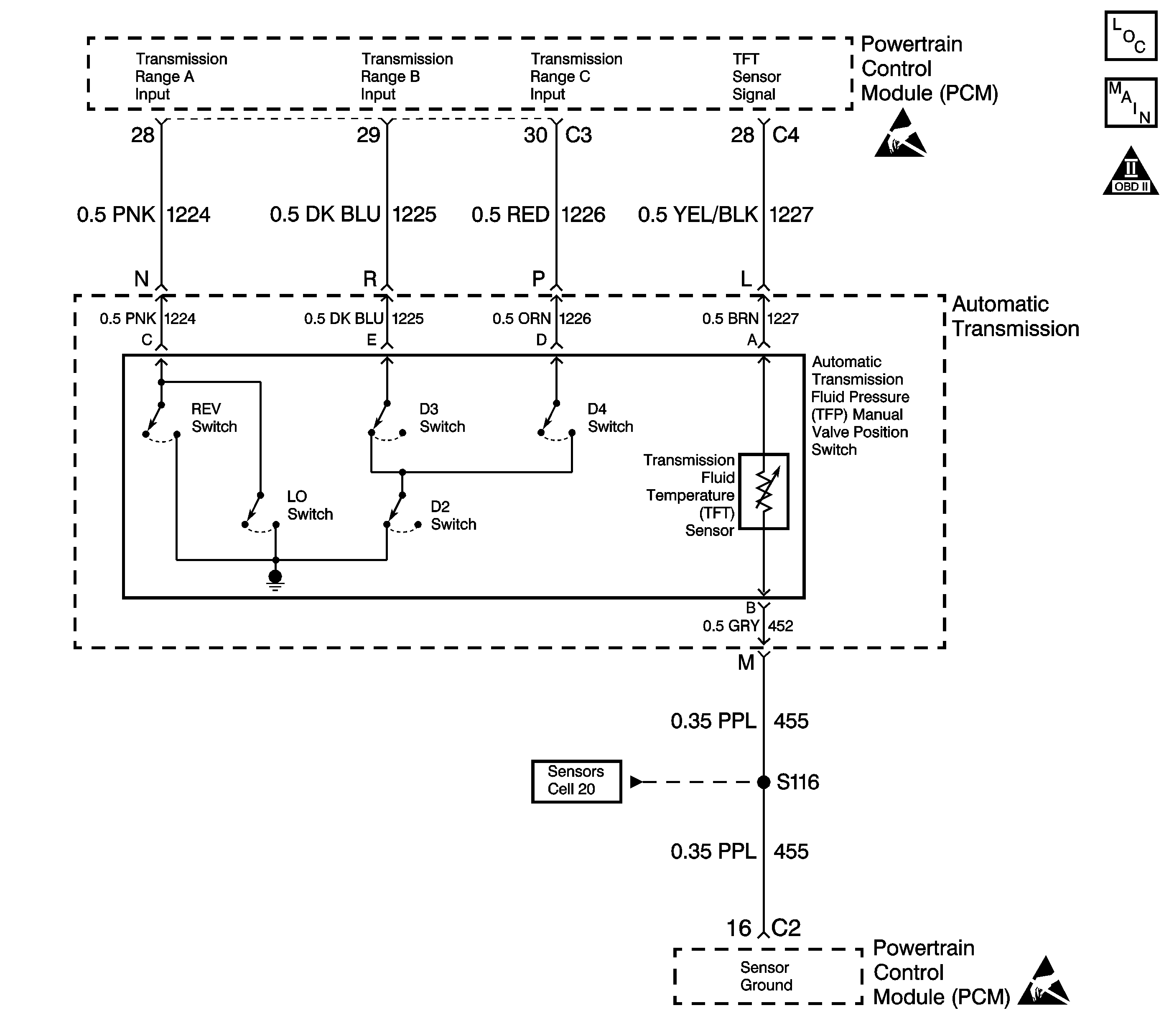
Circuit Description
The Automatic Transmission Fluid Temperature (TFT) sensor is a negative coefficient thermister within the Automatic Transmission Fluid Pressure (TFP) Manual Valve Position Switch. The TFT sensor controls the signal voltage from the PCM. The PCM supplies a 5-volt reference signal to the sensor on circuit 1227. When the transmission fluid is cold, the sensor resistance is high and the PCM detects high signal voltage. As the transmission fluid temperature increases, the sensor resistance decreases and the detected voltage decreases. At the transmission's normal operating temperature of 100°C (212°F), the voltage is approximately 1.5-2 volts.
If the PCM detects a continuous short to ground in the TFT signal circuit or the TFT sensor, in 2 consecutive ignition cycles, then DTC P0712 sets. DTC P0712 is a type B DTC.
Conditions for Setting the DTC
| • | The system voltage is 10-17 volts. |
| • | The ignition is ON. |
| • | The TFT sensor indicates a voltage less than 0.196 volts. |
| • | All conditions met for 10 seconds |
Action Taken When the DTC Sets
| • | The transmission default temperature is 135°C (275°F). |
| • | The PCM freezes shift adapts from being updated. |
| • | The PCM illuminates the Malfunction Indicator Lamp (MIL). |
Conditions for Clearing the MIL/DTC
| • | The PCM turns OFF the MIL after three consecutive ignition cycles without a failure reported. |
| • | A scan tool can clear the DTC from the PCM history. The PCM clears the DTC from the PCM history if the vehicle completes 40 warm-up cycles without a failure reported. |
| • | The PCM cancels the DTC default actions when the fault no longer exists and the ignition is OFF long enough in order to power down the PCM. |
Diagnostic Aids
| • | If a transmission fluid overtemperature DTC P1812 is also set, inspect the transmission cooling system for blockage and restrictions. |
| • | Inspect the harness routing for a short to ground in circuit 1227. The scan tool TFT display should rise steadily to about 100°C (212°F), then stabilize. |
| • | Inspect the wiring for poor electrical connections at the PCM. Look for the following conditions: |
| - | A bent terminal |
| - | A backed out terminal |
| - | A damaged terminal |
| - | Poor terminal tension |
| - | A chafed wire |
| - | A broken wire inside the insulation |
| • | When diagnosing for an intermittent short or open condition, massage the wiring harness while watching test equipment for changes. |
| • | Use the Temperature Versus Resistance scale in order to test the TFT sensor at various temperatures. Test the TFT sensor in order to eliminate the possibility of a skewed (mis-scaled) sensor. A skewed sensor could result in delayed garage shifts or TCC complaints. |
| • | Inquire about the customer's driving habits, trailer towing, etc. . . |
Test Description
The numbers below refer to the step numbers on the diagnostic table.
-
This step verifies that a problem exists in the TFT Sensor circuit.
-
This step creates an open. This step uses the open in order to test for an internal fault within the transmission.
-
This step verifies that the resistance of the TFT wiring and the TFT Sensor is within specifications at 20°C (68°F). In order to verify the resistance at other transmission fluid temperatures, you must refer to the Temperature Versus Resistance table.
Step | Action | Value(s) | Yes | No | ||||||
|---|---|---|---|---|---|---|---|---|---|---|
1 | Was the Powertrain On-Board Diagnostic (OBD) System Check performed? | -- | Go to Powertrain On Board Diagnostic (OBD) System Check , Section 6. | |||||||
2 | Examine the transmission fluid. Refer to Transmission Fluid Check . Have you performed the fluid checking procedure? | -- | Go to Transmission Fluid Check | |||||||
Important: Before clearing the DTCs, use the scan tool in order to record the Freeze Frame and Failure Records for reference. The Clear Info function will erase the data. Does the scan tool display a TFT Sensor signal voltage less than the voltage specified? | 0.196 volts | Go to Diagnostic Aids | ||||||||
Does the TFT Sensor signal voltage change to greater than the voltage specified? | 4.92 volts | |||||||||
Important: This resistance range is valid at 20°C (68°F). In order to verify the TFT Sensor at other temperatures, refer to the Temperature Versus Resistance table. Is the resistance within specifications? | 3088-3941ohms | Go to Diagnostic Aids | ||||||||
6 |
Refer to Transmission Oil Pan Removal. Refer to Electrical Diagnosis, Section 8A. Did you find and correct a problem? | -- | ||||||||
7 |
Important: This resistance range is valid at 20°C (68°F). In order to verify the TFT Sensor at other temperatures, refer to the Temperature Versus Resistance table. Is the resistance within specifications? | 3088-3941ohms | Go to Diagnostic Aids | |||||||
8 | Replace the TFP Valve Position Switch. Refer to Control Valve Body and Pressure Switch, in On-Vehicle Service. Is the replacement complete? | -- | -- | |||||||
9 | Inspect circuit 1227 (YEL/BLK) for a short to ground. Refer to Electrical Diagnosis, Section 8. Did you find and correct a problem? | -- | ||||||||
10 |
Did you find and correct a problem? | -- | ||||||||
11 | Replace the PCM. Refer to PCM Replacement Powertrain Control Module Replacement/Programming , Section 6. Is the replacement complete? | -- | -- | |||||||
12 |
Has the test run and passed? | -- | System OK |
